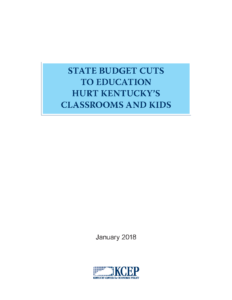Click to view report as a PDF.

Education is crucial to Kentucky’s success. However, as the state legislature has been disinvesting in P-12 education over the past decade, it has forced school districts to make cuts that harm classrooms and kids. Through a survey of Kentucky’s school districts and review of other state data, this report provides a first comprehensive look at how these cuts have translated into fewer course offerings, reductions in school-based services, fewer staff and cuts in employee compensation, costs being passed along to parents, fewer instructional days and more.
While Kentucky lawmakers have attempted to protect education funding in some ways, indirect cuts to core funding and direct cuts to educational supports are taking a toll. Kentucky’s per-student, inflation-adjusted cuts to its core funding formula — SEEK (Support Education Excellence in Kentucky) — since 2008 are third worst in the nation for cuts to core formula funding for K-12 education. And state funding for textbooks, professional development and extended school services have been cut outright — by about 20 percent each since 2008 even before inflation is taken into account. There were even several years the state provided no funding for textbooks at all.
KCEP’s survey of Kentucky’s school districts provides more detailed information on the impacts of inadequate appropriations on districts. The sample of districts responding to the survey represents more than 74 percent of Kentucky students. The sample is also representative in terms of geography, district size and per-student property assessments (a measurement of district wealth). We also analyzed data from the Kentucky Department of Education (KDE).
The first section of this report provides context for districts’ funding challenges as well as examples of these challenges from survey responses: eroding state funding, a shift in responsibility from the state to local districts, additional fiscal strain caused by multiple factors and the overall importance of funding to improve educational outcomes.
The second part of the report draws on the survey and other data to categorize and detail the difficult budget decisions districts are facing as a result of the challenging funding environment. Even as they are increasing local tax effort to compensate for lagging state investment, many Kentucky school districts have had to reduce investment in staffing, student supports, enrichment opportunities, instructional resources and more. Ultimately, this erosion in services will harm educational outcomes and hinder our ability to build thriving communities across the commonwealth.




